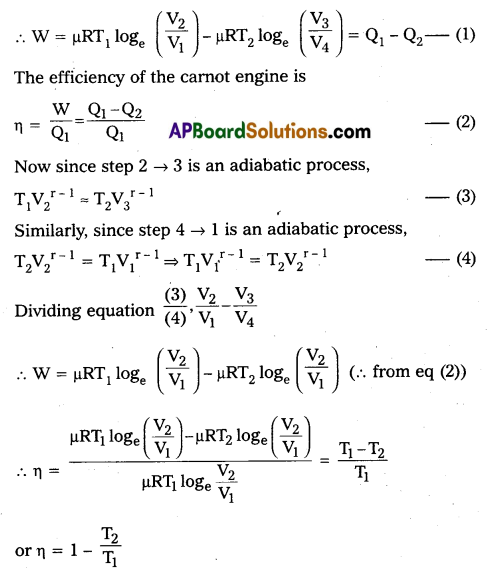Thoroughly analyzing AP Inter 1st Year Physics Model Papers and AP Inter 1st Year Physics Question Paper March 2018 helps students identify their strengths and weaknesses.
AP Inter 1st Year Physics Question Paper March 2018
Time: 3 Hours
Maximum Marks: 60
Section – A (10 × 2 = 20)
Note :
- Answer all questions.
- Each question carries two marks.
- All are very short answer type questions.
Question 1.
What is the discovery of C.V. Raman ?
Answer
In elastic scattering of light by molecules.
Question 2.
How can systematic errors be minimised or eliminated ?
Answer:
Systematic errors can be minimised by improving experimental techniques, selecting better instruments and removing personal bias as far as possible. For a given set up, these errors may be estimated to a certain extent and the necessary corrections may be applied to the readings.
Question 3.
When two right angled vectors of magnitude 7 units and 24 units combine, what is the magnitude of their resultant ?
Answer:
θ = 90°, P = 7 units, Q = 24 units, R = \(\sqrt{\mathrm{P}^2+\mathrm{Q}^2+2 \mathrm{PQ} \cos \theta}\)
R = \(\sqrt{7^2+24^2+2 \times 7 \times 24 \times \cos 90^{\circ}}\)
= \(\sqrt{49+576}\) = \(\sqrt{625}\) = 25 units.
![]()
Question 4.
A horse has to pull harder during the start of the motion than later. Explain.
Answer:
We know the limiting frictional force is greater than kinetic frictional force. For starting motion of the cart, the limiting friction is to be overcome. Once motion is set, frictional force reduces. Therefore, the horse has to pull harder during starting of the cart.
Question 5.
Why are drops and bubbles spherical ?
Answer:
The surface tension of a liquid tends to have minimum surface area. For a given volume, the surface area is minimum for a sphere. Hence rain drops are spherical shape.
Question 6.
Mention any two examples that obey Bernoulli’s theorem.
Answer:
- In heavy winds house roofs are blown off. When the velocity of the wind is greater on the roof top than inside the house, then the pressure on the roof top becomes less than that inside the house. This pressure difference causes the dynamic lift.
- When a fan is rotating, papers are blown off from the table top. The velocity of wind on the paper increases due to fan and hence pressure decreases. Due to this pressure difference papers are blown off.
Question 7.
State Newton’s law of cooling.
Answer:
The rate of loss of heat is directly proportional to the difference in temperature between the body and its surrounding provided the temperature difference is small, i.e., – \(\frac{\mathrm{dQ}}{\mathrm{dt}}\). ∝ (T – Ts)
Question 8.
Can substance contract on heating ? Give an example.
Answer:
Yes, Rubber, type metal, cast iron are contract on heating.
Question 9.
State Boyle’s law and Charles’ law.
Answer:
Boyle’s law : At constant temperature, the pressure of a given mass of gas varies inversely with volume.
P ∝ \(\frac{1}{V}\) ⇒ PV = Constant.
Charle’s law : At constant pressure, the volume of the gas is proportional to its absolute temperature.
V ∝ T
Question 10.
Define mean free path.
Answer:
The average distance covered by a molecule between two successive collisions is called the mean free path.
![]()
Section – B (6 × 4 = 24)
Note :
- Answer any six questions.
- Each question carries four marks.
- All are short answer type questions.
Question 11.
Show that the trajectory of an object thrown at certain angle with the horizontal is a parabola.
Answer:
Consider a body is projected with an initial velocity (u) making an angle θ with the horizontal. The body does not experience acceleration in horizontal direction.

The velocity of the projectile can be resolved into (i) u cos θ, horizontal component (ii) u sin θ, vertical component. The horizontal component of velocity remains constant through out the motion. Only its vertical component changes due to acceleration due to gravity (g).
The distance travelled along OX in time t is given by
x = u cos θ × t
t = \(\frac{\mathrm{x}}{\mathrm{u} \cos \theta}\) ……. (1)
The distance travelled along by in time t is given by
y = (u cos θ) t \(\frac{1}{2}\) gt2 ……… (2)
Substituting eq. (1) in eq. (2)
y = (u sin θ) \(\frac{\mathrm{x}}{\mathrm{u} \cos \theta}\) – \(\frac{1}{2}\) g (\(\frac{x^2}{u^2 \cos ^2 \theta}\)) [∵ u = u sin θ, a = -g, s = y]
y = x tan θ – (\(\frac{g}{2 u^2 \cos ^2 \theta}\)) x2
Let A = tan θ and B = \(\frac{g}{2 u^2 \cos ^2 \theta}\)
Y = Ax – Bx2
Where A and B are constants.
This is the equation of parabola.
∴ The trajectory of a projectile is parabola.
Question 12.
A car travels the first third of a distance with a speed of 10 kmph, the second third at 20 kmph and the last third at 60 kmph. What is its mean speed over the entire distance ?
Answer:
V1 = 10 kmph, V2 = 20 kmph, V3 = 60 kmph
<V> = \(\frac{3 V_1 V_2 V_3}{V_1 V_2+V_2 V_3+V_3 V_1}\)
= \(\frac{3 \times 10 \times 20 \times 60}{200+1200+600}\)
= \(\frac{36000}{2000}\)
<V> = 18 kmph
Question 13.
Mention the methods used to decrease friction.
Answer:
- Polishing : By polishing the surfaces of contact, friction can be reduced.
- Bearings : The rolling friction is less than the sliding friction hence free wheels of a cycle, motor car, dynamos etc., are provided with ball bearings to reduce friction. Bearings convert sliding motion into rolling motion.
- Lubricants : The lubricant forms a thin layer between surfaces of contact. It reduces the friction. In light vehicles or machines, oils like “three in one” are used as lubricants. In heavy machines grease is used. In addition to this they guard the mechanical parts from over heating.
- Streamlining : Automobiles and Aeroplanes are stream-lined to reduce the friction due to air.
![]()
Question 14.
Distinguish between centre of mass and the centre of gravity.
Answer:
| Centre of mass | Centre of gravity |
| 1. Point at which entire mass of the body is supposed to be concentrated, and the motion of the point represents motion of the body. | 1. Fixed point through which the weight of the body act. |
| 2. It refers mass of to body. | 2. It refers to the weight acting on all particles of the body |
| 3. In a uniform gravitational field centre of mass and centre of gravity coincide | 3. In a non-uniform gravitational field, centre of gravity and centre of mass do not coincide. |
| 4. Centre of mass of the body is defined to describe the nature of motion of a body as a whole. | 4. Centre of gravity of body is defined to know the amount of stability of the body when supported. |
Question 15.
Find the centre of mass of three particles at the vertices of an equilateral triangle. The masses of the particles are 100 gram, 150 gram and 200 gram respectively. Each side of the equilateral triangle is 0.5 m long.
Answer:
With the x – and y – axis choosen as shown Figure, the coordinates of points O, A and B forming the equilateral triangle are respectively (0, 0) (0.5, 0), (0.25, √3). Let the masses 100g, 150g and 200g be located at O, A and B be respectively, then,
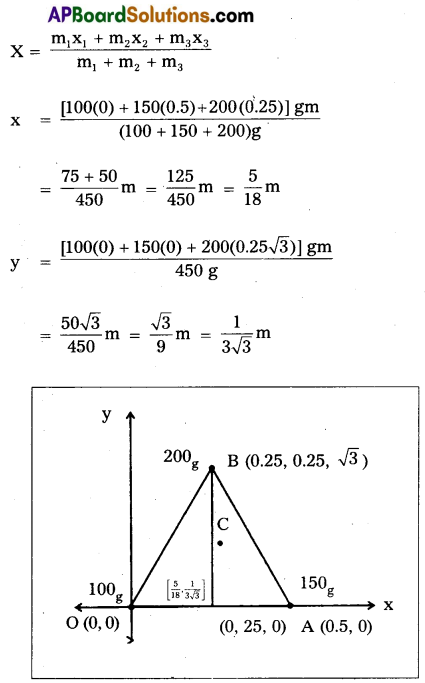
Question 16.
What is escape velocity ? Obtain an expression for it.
Answer:
Escape velocity : It is the minimum velocity with which a body should be projected, so that it moves into the space by overcoming the earth’s gravitational field.
Expression for escape velocity :
Consider a body of mass m thrown with a velocity Ve.
Then K.E = 1\(\frac{1}{2} m v_{\mathrm{e}}^2\) ……….. (1)
The gravitational force of attraction of the earth of mass M and Radius R on a body of mass m at its surface is
F = \(\frac{\mathrm{GMm}}{\mathrm{R}^2}\) …………. (2)
Gravitational P.E. = work done on the body
∴ P.E. = F × R = \(\frac{\mathrm{GMm}}{\mathrm{R}^2}\) × R,
P.E. = \(\frac{\mathrm{GMm}}{\mathrm{R}}\) …………. (3)
A body just escapes when its K.E. = P.E.
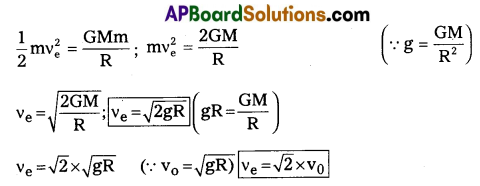
∴ Escape velocity is √2 times the orbital velocity.
Question 17.
Describe the behaviour of a wire under a gradually increasing load.
Answer:
Behaviour of a wire under the action of gradually increasing load:
When the load is increased in steps, a graph is drawn between stress in Y – axis and corresponding strain on X – axis. Then the curve obtained is as shown in the figure. When a wire be clamped at one end and loaded at the other end, it undergoes four following steps.

1) Proportional limit : In the linear position OA, stress is proportional to strain i.e., Hooke’s law is obeyed by the wire upto the point ‘A’, the graph is a straight line, Whenever the stretching force at ‘A’ is removed the wire regains its original length. ‘A’ is called proportional limit.
2) Elastic limit : In the graph ‘B’ is the elastic limit. Though the wire doesn’t obey Hooke’s law at ‘B’, the wire regains its original length after removing the stretching force at ‘B’. Upto point ‘B’ the wire is under elastic behaviour.
3) Permanent set (or) yield point : In the graph ‘C’ is the yield point. If the stretching force at ‘C’ is removed, the wire doesn’t regain its original length and the length of the wire changes permanently. In this position the wire flows like a viscous liquid. After the point ‘C’, the wire is under plastic behaviour. ‘C’ is called permanent set or yield point.
4) Breaking point : When the stress increases the wire becomes thinner and thinner. When the stress increases to a certain limit the wire breaks. The stress at which the wire breaks is called Breaking stress and the point ‘D’ is called Breaking point.
5) Elastic fatigue : The state of temporary loss of elastic nature of a body due to continuous strain is called elastic fatigue. When a body is subjected to continuous strain within the elastic limit it appears to have lost elastic property temporarily to some extent and becomes weak.
![]()
Question 18.
In what way is the anomalous behaviour of water advanta-geous to an aquatic animals ?
Answer:
In cold countries, as atmospheric temperature decreases, the upper layers of the lakes, rivers etc., cool, contract and sink to the bottom (fig). This goes on until the whole of the water reaches the temperature of 4°C. When the top layers cool further temperature falls below 4°C, it expands and becomes lighter. It does not sink downwards and remains at the top. With further cooling the top layer gradually form ice at the top (fig). Ice and water are bad conductors of heat. So the lower layers are protected against freezing by the layers of ice and cold water at 1°C, 2°C and 3°C. This results in water remaining at the bottom at 4°C. So that aquatic animals survive in those layers of water.

Section – C (2 × 8 = 16)
Note :
- Answer any two questions.
- Each question carries eight marks.
- All are long answer type questions.
Question 19.
State and prove law of conservation of energy in case of a freely falling body. A machine gun fires 360 bullets per minute and each bullet travels with a velocity of 600 ms-1. If the mass of each bullet is 5 gm, find the power of the machine gun.
Answer:
Statement : Energy can neither be created nor destroyed, but it can be converted from one‘form to another form. The total energy of a system always remains constant.
Verification in the case of freely falling body: Let a body of mass’m’ be at a height ‘h’ above the ground. When it is freely falling with an acceleration due to gravity ‘g’, the potential energy gradually decreases and at the same time the K.E. of the body increases.
When the body is at A :
At the highest point final velocity v = 0
Kinetic energy K.E. = \(\frac{1}{2}\)mv2 = 0
Potential energy P.E. = mgh
Total energy at A = E = P.E. + K.E. = mgh + 0
∴ Total energy at A, E = mgh ………. (1)

When the body is at B :
As the body falls freely, after travelling a distance x, reaches the point B.
At ‘B’ the body possesses both P.E. and K.E.
Potential energy P.E. = mg (h – x) P.E = mgh – mgx
Kinetic energy K.E. = \(\frac{1}{2} \mathrm{mv}_1^2\)
Total energy at B = RE + K.E.
= mgh – mgx + \(\frac{1}{2} \mathrm{mv}_1^2\)
For freely falling body
S = x
u = 0
v = v1
a = g
Sub., these values in eq.
v2 – u2 = 2as
\(\mathrm{v}_1^2\) – 02 = 2gx
\(\mathrm{v}_1^2\) = 2gx
Total energy at
B = mgh – mgx + \(\frac{1}{2}\) m.2gx
= mgh – mgx + mgx = mgh
∴ Total energy at B, E = mgh ……….. (2)
When the body is at C :
The body falls through a distance of ‘h’ and touches the ground at C with a velocity v2.
Potential energy at C = mg = 0
Kinetic energy K.E. = \(\frac{1}{2} \mathrm{mv}_2^2\)
Total energy at C = 0 + \(\frac{1}{2} \mathrm{mv}_1^2\) = \(\frac{1}{2} \mathrm{mv}_1^2\)
For freely falling body s = h, u = 0, v = v2, a = g
Sub. these values in eq. v2 – u2 = 2as ; \(\mathrm{v}_2^2\)– 02 = 2gh
= \(\mathrm{v}_2^2\) = 2gh
Sub. this value in total energy we get
Total energy at C = \(\frac{1}{2} \mathrm{mv}_2^2\) = \(\frac{1}{2}\) m 2gh
∴ Total energy at C = mgh
In the above three cases total energy of the body is proved constant. Hence law of conservation of energy is proved.
Problem : Here n = 360, t = 60 sec, v = 60 m/s
m = 5g = 5 × 10-3 kg
Power, P = \(\frac{\text { K.E.of bullets }}{t}=\frac{\frac{1}{2} \mathrm{mv}^2}{1}\)
= \(\frac{\frac{1}{2} \times 5 \times 10^{-3} \times 360 \times 600 \times 600}{60}\)
∴ P = 5400 W = 5.4 K.W
![]()
Question 20.
Define simple harmonic motion. Show that the motion of projection of a particle performing uniform circular motion, on any diameter, is simple harmonic. What is the length of the seconds pendulum. Which tick’s seconds ?
Answer:
“A body is said to be in simple harmonic motion, if it moves to and fro along a straight line, about its mean position such that, at any point its acceleration is directly proportional to its displacement in magnitude but opposite in direction and is directed always towards the mean position”.
If ‘a’ is the acceleration of the body at any given displacement y from the mean position, then for the body to be in S,H,M.
a ∝ – y or a = – ky
Where ‘k’ is constant of proportionality. (-) indicates that ‘a’ and ‘y’ are always in opposite directions.
Show that the projection of uniform circular motion on any diameter is simple harmonic :
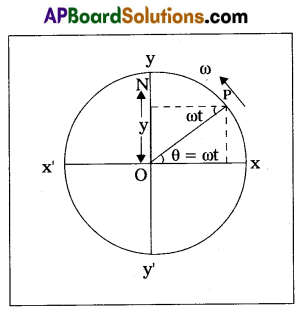
Consider a particle P moving on the circumference of a circle of radius A with uniform angular velocity ω. Let O be the centre of the circle. XX’ and YY’ are two mutually perpendicular diameters of the circle as shown in the figure. Let PN be drawn perpendicular to the diameter YY from P. As P moves on the circumference of the circle, N moves on the diameter YY to and fro about the centre O.
Let us consider the position of N at any time t, after leaving the point ‘O’, during its motion. The corresponding angular displacement of the particle P is ∠XOP= θ = ωt.
From Δle ONP sin.ωt \(\); ON = OP sin ωt (∵ ON = y, OP = A)
y = A sin ωt ……….. (1)
Differentiating equation (1) w.r.t’t’, we get velocity
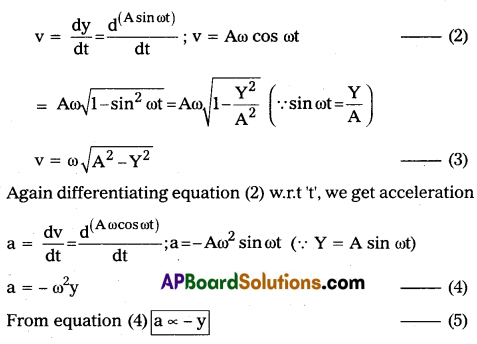
Hence acceleration is directly proportional to the displacement and opposite direction. Hence motion of N is simple harmonic.
![]()
Question 21.
Explain reversible and irreversible processes. Describe the working of Carnot engine. Obtain an expression for the efficiency.
Answer:
Reversible process : A process that can be retraced back in the opposite direction in such away that the system passes through the same states as in the direct process, and finally the system and the surroundings return in their original states, is called a reversible process.
A reversible process is only a purely idealised process.
Examples :
- Slow isothermal and slow adiabatic changes.
- Peltier effect and seeback effect.
- Fusion of ice and vaporisation of water.
Irreversible process : “A process that cannot be retraced back in the opposite direction” is called as irreversible process.
In this process the system does not pass through the same intermediate states as in the reversible process.
All natural processes such as conduction, radiation, radioactivity etc, are irreversible.
Example :
- Work done against friction.
- Heat produced in conductors by passing a current through it. (Joule heating)
- Diffusion of gases.
Carnot Engine : A reversible heat engine operating between two temperatures is called a carnot engine. The cycle operating it is known as carnot’s cycle. In this cycle the working substance (say an ideal gas) is taken through a cycle by means of two isothermals and two adiabatics. The four operations are shown in P – V (Indicator) diagram.
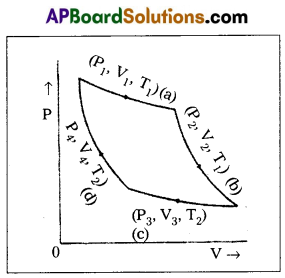
Step 1 → 2 : Isothermal expansion of the gas taking its state from (P1, V1, T1) to (P2, V2, T2). It is shown in curve (a).
The heat absorbed by the gas (Q1) from the reservoir at temperature T1 equals the workdone by the gas.
i.e. W1 → 2 = Q1 = μRT1 loge \(\frac{V_2}{V_1}\) → (1)
Step 2 → 3 : Adiabatic expansion of the gas from (P2, V2, T1) to
(P3, V3, T2). It is shown in curve (b). The work done by the gas is given by
W2 → 3 = \(\frac{\mu R\left(T_1-T_2\right)}{(r-1)}\) → (2)
Step 3 → 4 : Isothermal compression of the gas from (P3, V3, T2) to (P4, V4, T2). It is shown in curve (c).
Heat released (Q2) by the gas to the reservoir at temperature T2 equals the work done on the goes.
i.e., W3 → 4 = μRT2 loge\(\frac{V_4}{V_3}\) = – μ RT2 loge\(\frac{V_3}{V_4}\)
Step 4 → 1 : Adiabatic compression of the gas from (P4, V4, T2) to (P1, V1, T1). It is shown incurve (d).
W4 → 1 = μR \(\frac{\left(T_2-T_1\right)}{(r-1)}\) = – μR \(\frac{\left(T_1-T_2\right)}{(r-1)}\)
Total workdone by the gas in one complete cycle is
W = W1 → 2 + W2 → 3 + W3 → 4 + W4 → 1

